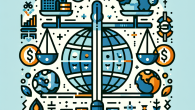
Gold, Bonds, and Geopolitical Risk: Reading the Tea Leaves Correctly
The Global Shift: How Central Bank Policy Is Reshaping Financial Markets
If global finance were a symphony, central banks would be the conductors—wielding interest rates instead of batons, and quantitative easing like unexpected cymbal crashes. And just as in music, a single mistimed note can send shockwaves through the entire performance. In recent years, central bank policies have done far more than keep inflation at bay—they have upended traditional market behavior and rewritten the score of international capital allocation.
So, fasten your cufflinks and pour yourself a strong black tea—we’re about to deep dive into the recalibration of global markets through the lens of monetary maestros.
From the Great Moderation to the Great Recalibration
Let us begin with a brief voyage through history. The early 2000s were coined the era of the “Great Moderation”—a period noted for sustained economic growth, mild recessions, and tamed inflation. Central banks, especially the U.S. Federal Reserve, mastered the art of steady rate adjustments. However, the 2008 Global Financial Crisis sent a shudder through this system, and since then, monetary policy has become rather more experimental.
We entered the realm of:
- Zero and Negative Interest Rates – In a desperate attempt to encourage borrowing and investment, many central banks went subzero. Yes, that’s right—imagine being charged to save money. One might call it economic insult added to recessionary injury.
- Quantitative Easing (QE) – A euphemism for printing digital money to buy government bonds and other financial assets. This injected liquidity into markets but also artificially inflated asset prices.
- Forward Guidance – Less a policy, more an elaborate form of economic theatre, where central bankers hint at future moves to manipulate market expectations.
While these unconventional methods were initially seen as emergency maneuvers, they have since become permanent fixtures in the toolkit of every monetary authority worth their salt—or gold reserves, as it were.
Global Ripple Effects: Emerging Markets in the Crosshairs
One of the most defining consequences of central bank activism has been its impact on emerging markets. U.S. and European interest rate policies don’t just affect their domestic economies—they cause seismic shifts across the developing world.
Let’s take the classic case of the “Taper Tantrum” of 2013. The mere whiff that the U.S. Fed might wind down its QE program led to massive capital outflows from countries like India, Turkey, and Brazil. Their currencies depreciated, bond yields soared, and central banks scrambled to defend the integrity of their markets.
In today’s environment, these tensions have worsened. With the Federal Reserve and the European Central Bank aggressively tightening policies to combat inflation post-COVID, global investors are reallocating their capital en masse:
- Dollar Inflows Rise – A strong dollar means capital flood into U.S. Treasuries, seen as a safe haven amid higher yields.
- Emerging Markets Bleed – Capital exits EM equities and bonds, increasing volatility and weakening local currencies.
- Debt Servicing Costs Soar – Many EM nations borrow in dollars. A stronger dollar exacerbates debt burdens, risking default.
For those of us observing from a mahogany-paneled academic office or a long trading desk stacked with terminals, this scenario underscores a crucial reality: global markets are no longer interconnected—they are interdependent.
The Return of Inflation and Policy Divergence
Another puzzling development has been the return of that old economic nemesis: inflation. After decades of dormancy, it awakened with fierce vengeance in 2021–2022. Supply chain disruptions, colossal stimulus packages, and energy shocks due to geopolitical tensions all contributed to price levels that would give any 1980s economist déjà vu.
Central banks responded with renewed hawkishness—but not all at the same pace. Hence, we now live in the era of policy divergence:
- The U.S. Fed has taken an aggressive stance, pushing rates over 5% and committing to “higher for longer.”
- The ECB follows suit, albeit with more caution, tethered by high sovereign debt in member states like Italy and Spain.
- Japan’s Bank of Japan remains the lone dove, maintaining ultra-loose policy amid decades of deflationary ghosts.
This divergence leads to extreme dislocations in currency markets, bond yields, and cross-border investment flows. A trader’s delight—but a policymaker’s migraine.
Asset Classes in the Wake of Monetary Shift
The impact of central bank policy is visible in virtually every major asset class. Allow me to illustrate:
1. Bonds
The era of cheap money drove yields to historic lows. Now, with tighter monetary policy, yields have risen sharply, causing massive mark-to-market losses on long-duration bond portfolios. Pension funds and insurance firms—traditionally major bondholders—must reassess their allocations.
2. Equities
Ultra-low interest rates propped up valuations through discounted cash flow models. However, as the cost of capital increases, P/E ratios are under pressure. Tech stocks, once darlings of quantitative easing, are particularly sensitive to rate hikes.
3. Real Estate
In a zero-rate world, real estate became the go-to asset for yield-seeking investors. That dynamic is fading quickly. Rising rates mean higher mortgage costs, reduced affordability, and cooling property markets across North America and Europe.
4. Commodities
Monetary policy indirectly influences commodities via exchange rates and investment flows. A strong dollar typically suppresses commodity prices, but supply-side pressures (like war in Ukraine) have introduced unpredictable countercurrents.
Looking Ahead: Strategic Implications for Investors
So where does this leave us? Navigating post-pandemic monetary realignment requires both strategic agility and intellectual sobriety. Investors and policymakers must embrace a new playbook, one that incorporates:
- Currency Hedging – Non-USD investors must account for dollar volatility in global asset portfolios.
- Duration Risk Management – Bond investors must scrutinize interest rate sensitivity across maturity profiles.
- Geopolitical Risk Assessment – Monetary policy no longer acts in a vacuum. Geopolitics is now a determinant, not a footnote.
Those who cling to pre-2020 frameworks may find themselves ill-equipped to navigate the renewed complexity of global markets. On the other hand, those who adapt intelligently can seize immense opportunities in this era of structural realignment.
Final Thoughts from the Belfry
In conclusion, central banks aren’t simply firefighters of financial crises anymore—they are chief architects of global capital flow. Their every announcement, pause, or pivot conjures waves that ripple across continents and asset classes.
Investing today is no longer a matter of “buy low, sell high.” It’s about reading the language of policy, predicting its consequences, and positioning ahead of the herd. And as Dr. Alistair P. Whitmore always says: “Never discount the man with the printing press.”
To learn more about the mission behind our insights, visit our about us page. Questions or commentary, as always, may be directed via our contact page.









Leave a Reply